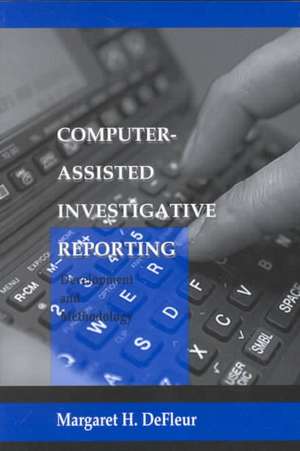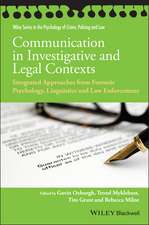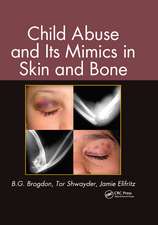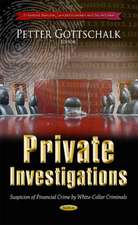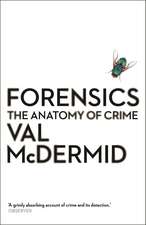Computer-assisted Investigative Reporting: Development and Methodology: Routledge Communication Series
Autor Margaret H. DeFleuren Limba Engleză Paperback – feb 1997
This unique volume addresses procedures and issues in investigative journalism that have not been explained in other publications. It sets forth -- for the first time -- a detailed and specific methodology for conducting computer-assisted investigative analyses of both large and small scale electronic records of government and other agencies. That methodology consists of the logic of inquiry, strategies for reaching valid conclusions, and rules for reporting what has been revealed by the analyses to the public in clear ways. Such systematic methodologies are essential in social and other sciences and the development of a counterpart for investigative journalism has been badly needed.
That systematic methodology is developed within a context that explains the origin and major characteristics of those elements that have come together in American society to make computer-assisted investigative reporting both possible and increasingly a part of standard newsroom practices. These include the development of traditional investigative journalism, the evolution of computer technology, the use of computers by government to keep records, the legal evolution of freedom of information laws, the rapid adoption of computers in newsrooms, the increasing importance of precision journalism, and the sharp increase in recent times of computer-assisted investigative reporting by American newspapers both large and small. The issues addressed in this book are discussed in a very readable context with an abundance of examples and illustrations drawn from the real world of journalism as it is practiced daily in newsrooms around the country. Explanations of concepts, principles, and procedures are set forth in layperson's terms that require very little in the way of knowledge of computers or statistical methods.
| Toate formatele și edițiile | Preț | Express |
|---|---|---|
| Paperback (1) | 235.13 lei 43-57 zile | |
| Taylor & Francis – feb 1997 | 235.13 lei 43-57 zile | |
| Hardback (1) | 686.42 lei 43-57 zile | |
| Taylor & Francis – feb 1997 | 686.42 lei 43-57 zile |
Din seria Routledge Communication Series
-
 Preț: 156.78 lei
Preț: 156.78 lei -
 Preț: 155.43 lei
Preț: 155.43 lei - 8%
 Preț: 516.77 lei
Preț: 516.77 lei - 8%
 Preț: 441.77 lei
Preț: 441.77 lei - 8%
 Preț: 415.39 lei
Preț: 415.39 lei - 9%
 Preț: 576.43 lei
Preț: 576.43 lei - 9%
 Preț: 575.54 lei
Preț: 575.54 lei - 8%
 Preț: 439.26 lei
Preț: 439.26 lei - 8%
 Preț: 509.90 lei
Preț: 509.90 lei -
 Preț: 392.96 lei
Preț: 392.96 lei - 8%
 Preț: 387.31 lei
Preț: 387.31 lei -
 Preț: 416.20 lei
Preț: 416.20 lei - 15%
 Preț: 424.83 lei
Preț: 424.83 lei -
 Preț: 358.85 lei
Preț: 358.85 lei -
 Preț: 357.88 lei
Preț: 357.88 lei - 22%
 Preț: 325.34 lei
Preț: 325.34 lei - 15%
 Preț: 455.70 lei
Preț: 455.70 lei - 15%
 Preț: 456.52 lei
Preț: 456.52 lei -
 Preț: 360.72 lei
Preț: 360.72 lei -
 Preț: 259.42 lei
Preț: 259.42 lei - 16%
 Preț: 247.75 lei
Preț: 247.75 lei -
 Preț: 348.37 lei
Preț: 348.37 lei -
 Preț: 368.03 lei
Preț: 368.03 lei - 22%
 Preț: 321.54 lei
Preț: 321.54 lei -
 Preț: 411.14 lei
Preț: 411.14 lei -
 Preț: 473.46 lei
Preț: 473.46 lei -
 Preț: 425.04 lei
Preț: 425.04 lei -
 Preț: 490.53 lei
Preț: 490.53 lei -
 Preț: 363.55 lei
Preț: 363.55 lei - 24%
 Preț: 133.28 lei
Preț: 133.28 lei - 31%
 Preț: 325.43 lei
Preț: 325.43 lei - 25%
 Preț: 769.37 lei
Preț: 769.37 lei -
 Preț: 439.57 lei
Preț: 439.57 lei - 18%
 Preț: 712.22 lei
Preț: 712.22 lei -
 Preț: 386.09 lei
Preț: 386.09 lei -
 Preț: 245.50 lei
Preț: 245.50 lei -
 Preț: 388.17 lei
Preț: 388.17 lei -
 Preț: 357.88 lei
Preț: 357.88 lei - 18%
 Preț: 988.41 lei
Preț: 988.41 lei -
 Preț: 340.12 lei
Preț: 340.12 lei -
 Preț: 373.87 lei
Preț: 373.87 lei - 26%
 Preț: 243.26 lei
Preț: 243.26 lei -
 Preț: 95.89 lei
Preț: 95.89 lei -
 Preț: 240.24 lei
Preț: 240.24 lei - 20%
 Preț: 396.57 lei
Preț: 396.57 lei -
 Preț: 222.06 lei
Preț: 222.06 lei -
 Preț: 379.68 lei
Preț: 379.68 lei -
 Preț: 237.00 lei
Preț: 237.00 lei - 18%
 Preț: 945.15 lei
Preț: 945.15 lei
Preț: 235.13 lei
Nou
Puncte Express: 353
Preț estimativ în valută:
45.01€ • 46.29$ • 37.34£
45.01€ • 46.29$ • 37.34£
Carte tipărită la comandă
Livrare economică 17 februarie-03 martie
Preluare comenzi: 021 569.72.76
Specificații
ISBN-13: 9780805821635
ISBN-10: 0805821635
Pagini: 262
Dimensiuni: 152 x 229 x 17 mm
Greutate: 0.48 kg
Ediția:New.
Editura: Taylor & Francis
Colecția Routledge
Seria Routledge Communication Series
Locul publicării:Oxford, United Kingdom
ISBN-10: 0805821635
Pagini: 262
Dimensiuni: 152 x 229 x 17 mm
Greutate: 0.48 kg
Ediția:New.
Editura: Taylor & Francis
Colecția Routledge
Seria Routledge Communication Series
Locul publicării:Oxford, United Kingdom
Public țintă
ProfessionalCuprins
Contents: From Bordello to Watergate and Beyond: The Changing Nature of Investigative Reporting. Coming Together: Computers, Government Record Keepers and Journalists. Freedom of Information Laws: The Legal Status of Electronic Records. Computer-Assisted Investigative Reporting: Its Development, Definition and Current Status. Basic CAIR Techniques: As Used in Contemporary Newsrooms. Analyzing Large-Scale Electronic Records: An Example Using Data From the Federal Courts. CAIR Analyses and the Press: Problems of Reporting on Disclosures. Social Science, Precision Journalism, and CAIR: A Conceptual Comparison. A Formal Methodology for CAIR Analysis. Appendix.
Recenzii
"...offers a formal 'systematic methodology' for large database analysis...reflects considerable thought...provides...added value."
—Journalism & Mass Communication
—Journalism & Mass Communication
